Social Media Ad Audiences Guide
If you’ve spent any amount of time creating social media content, you already know that it’s different than talking into the void of your own website. When you add content to a website, you might unconsciously know that there are people reading your site, but with social media, you become very conscious right away that someone is watching (and talking back).
This revelation can be both hopeful and a little scary. After all, once you know that people are talking back, you’re instantly aware of the need for quality control and getting the right message out in real-time. A good rule of thumb about social media is that you need to tailor your content to your audience. Sounds easy, right?
It isn’t. In fact, it takes a little bit of study, work, and dedication to make sure that you attract the kind of audience you want and then give them the message they want. This give and take is tricky at first as you’re learning the ropes, but once you’ve attracted the right audience and identified who they are, you can pick out ads for this audience that will be profitable to you. For example, the fact that Facebook users have increased steadily over the last 10 years, earning the coveted #1 postition in social media, also makes it one of the top platforms for advertising, as well. Check out the statistics:
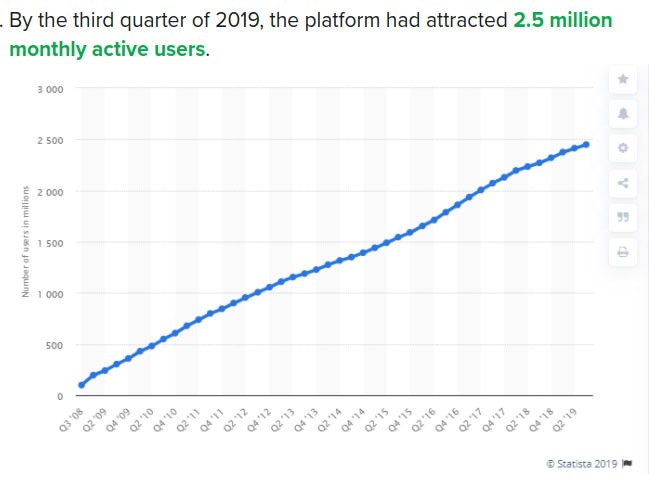
(Image credit: sproutsocial)
Why Your Social Media Audience Matters
Think of your audience as your biggest fans and partners in success. You’re putting out content that they enjoy, and in return, they’re visiting your social media sites and giving you a chance to be profitable. There’s a delicate balance here as a content creator speaking to an audience. You want to advertise and monetize your social media content, but you also want to make sure that your audience stays attentive and isn’t offended by your ad selection.
How important is social media advertising? Well, it’s so important that in 2019 it surpassed print advertising in global ad statistics. Businesses and individuals now spend more money to advertise to social media followers than they do in print publications. That’s a good indication of just how important your social media ad audience is to your success.
Your social media ad audience is going to be a group of people who follow your content, read your posts, interact with your page, and of course, people who might potentially interact with your ads and earn you either ad revenue or product sales. Your audience is important in more ways than just advertising, but if you’re going to stay in business for long, you need to know exactly who you want your social media ad audience to be and make sure that they’re the people you’re engaging with online. An SEO social analytics dashboard, like Diib® provides, can be a huge source of information about the demographics and user habits of your target audience. For example:
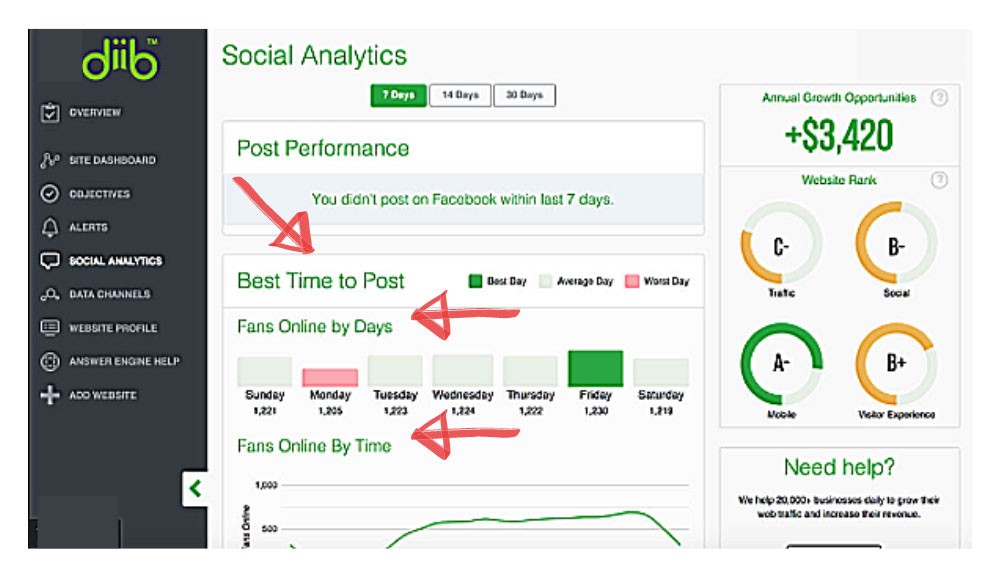
When you start an ad campaign, you’re investing a lot of money and time to bring it to life. If it’s geared to an audience that doesn’t exist – or that has no interest whatsoever in what your ads say – then you’re going to potentially lose a lot of money and time (two things no one wants to lose). To make sure your advertising is targeted, you can implement a strategy that brings out your best social media advertising results.
The Big Four Social Media Websites
Facebook, Pinterest, Twitter, and Instagram are, for advertising purposes, the center of the social media universe. If you’re going to invest money in advertising, these are the four properties you need to focus on. Facebook advertising alone generates almost $40 billion a year for the company. That’s a signal to you that businesses know Facebook ads work to generate a revenue stream.
Each of these sites will have a different audience. Facebook is more of a family picnic where a person’s lifetime social network congregates together to share daily life and opinions. For example, if you sell food kits, an ad on Facebook would be ideal:

(Image credit: WordStream)
Twitter has a more news-oriented slant with random thoughts, opinions, and targeted news stories playing out over the day. This is an example of a good tweet and gives some great information, as well:
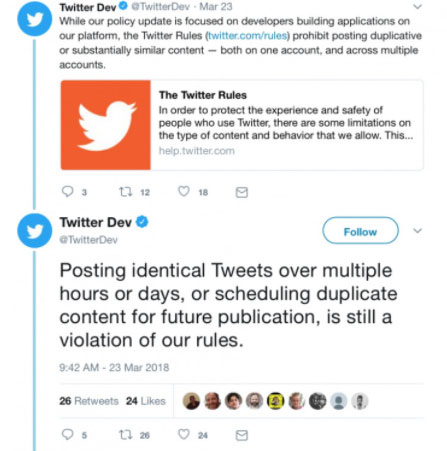
You Might Also Like
(Image credit: bigcommerce)
Instagram focuses on visuals and pictures; any business that focuses on selling utilizing primarily images should consider advertising on this platform. For example:

(Image credit: later)
And last but not least, Pinterest is a diary of all the interesting things people are interested in (crafts, memes, funny cats, etc.). For example, if you are advertising your new coupon app, advertising on a board where a woman would frequent would be ideal:

(Image credit: getonlinenola)
Your content’s subject matter will help you determine which of the big four you want to focus on (and in some cases you’ll want to advertise on all of them). For example, if you sell shoes on your website and nothing else, that doesn’t mean you’ll want to skip Facebook’s family picnic. After all, family members love shoes, too, and they might even share pics of your fabulous shoes with their friends and family. If you’re on a budget, though, you’ll want to really decide if all of these suit your purposes or just a couple of them.
As your monetization from your content grows, then you can expand and advertise on all of the social networks, but it’s okay to start with one and perfect your formula. Pick the one that most closely matches your audience’s personality and style. Take a look at these statistics for Facebook usage and growth over the last decade.
Test your website’s SEO and social media score in 60 seconds!
Diib is one of the best SEO and social media monitoring tools in the world. Diib syncs to Facebook and Google Analytics and uses the power of big data to help you quickly and easily increase your social media traffic and SEO rankings.
- Easy-to-use automated social media + SEO tool
- Keyword and backlink monitoring + ideas
- Speed, security, + Core Vitals tracking
- Automated ideas to improve Social Media traffic + sales
- Over 500,000 global members
- Built-in benchmarking and competitor analysis
Used by over 500k companies and organizations:
Syncs with 
Best Social Media Advertising Practices
The #1 best practice that almost all marketers universally agree on is that you need to find your audience first. For example, if your Facebook ads don’t reach and move your audience, they’re going to be screaming into the void just like a website with no traffic. Facebook ads especially must really speak to the right audience in order to be profitable and worthwhile.
Facebook is a terrific place to explore further here because they have three types of specific audiences you can choose from in your Ad Manager. Because they’ve got this down to a science, studying their strategies can help you pick out the type of audience you want to advertise to (and have that audience be the right pick). Here is what that page would look like:
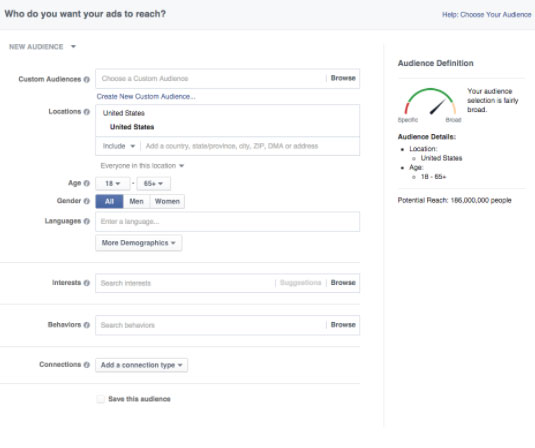
Social media advertising isn’t down to a science yet, no, but some social media websites understand more than others how to craft the right ads and pick the right audience for certain messages.
Social Media Advertising Examples
Let’s look at a couple of social media advertising examples so that you get an idea of how to pick the right ad audience for your social media sites. We’ll take a simple product: a short book on the history of Presidential elections. You wrote this book yourself and want to advertise it on your Facebook page. Good answers always come from asking the right questions. To pick your audience for this specific ad, look at your demographics and then ask yourself:
- How old is my audience?
- Where do they live?
- What is their educational background?
- What is their income range?
- How often do they visit my page?
Once again, I have to mention the Diib social analytics tool. It has the ability to give you at-a-glance answers to the questions above. It can also give you an Performance Overview for your target audience. Things like CTR, reactions, viral mulitpliers for specific posts and in different time increments. Here is what that would look like:
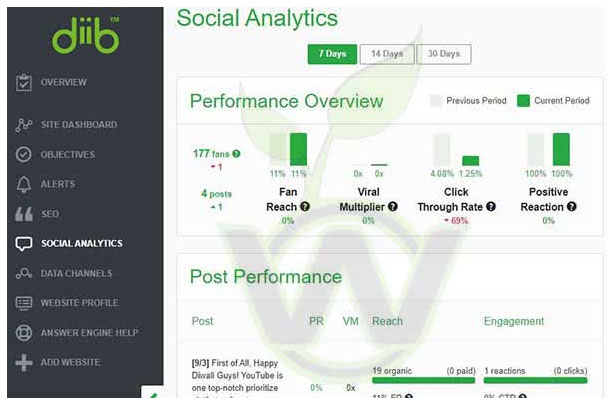
The general demographics of your audience will help you begin to envision the type of person who would visit your page and then become intrigued by an social media ad about your election book. What kind of person is interested in election history? What would their education be? What is their political affiliation? Facebook’s demographics give you a huge array of information about your followers and their own members so that you can deeply target your advertising to say just the right thing to the right type of person.
What’s the Message?
Tailoring your message to your ad audience is the second step of a successful plan for social media marketing. Once you envision your audience and know who they are, you can speak to them in a language that makes sense to them. In some ways, this is like putting yourself in someone else’s shoes and then asking yourself, “If I were this person, what message would speak to me? What would the best social media ads say about this topic if I were this person?”
Going back to our social media ads examples, remember the book about elections. You’re the one who wrote it. Does it focus on recent elections, distant ones, or all of them? Does it speak more to republicans or democrats or both? Is it written in an energetic, youthful voice that throws some emotion in there or is it cold, hard historical facts and science that a more analytical person might like? It’s just as important to know your product as it is to know your audience.
If your book is for a more youthful audience, and you have a lot of social media content or followers who are younger, then you can go more informal with your social media ads examples. For example, “Taking a break from classes today? Why not learn a little about our country’s election history?” If the book is more analytical and cold, hard facts, then you can maybe throw in an interesting historical fact and then simply ask your visitors to “click to learn more interesting facts.”
The golden rule is that the best social media ads will always talk in the voice that is most intriguing to your audience, and if you know your audience well, there’s a great chance that you can craft ads that are handpicked for your audience. And those ads will be successful and bring you either ad revenue or a click on your ad that leads to a product purchase. This is a great example of a highly targeted ad. They pull you in with an interesting photo, a giveaway and hashtags for increased visibility. It is also very interactive and encourages viewers to comment and share the post.

(Image credit: Pinterest)
Tips on Picking Ad Audiences
When reading anything about social media marketing, it might all sound straightforward and simple, but nothing in a fiercely competitive online marketing world is ever simple or straight forward (or usually all that successful in the beginning). Chances are that you’ll have to try a few ads and see how they perform before you can really tweak your formula and start to see legitimate success.
Your goal is to always pick the right kind of ad audiences, and that’s a steep order in an advertising landscape that reaches billions of people everyday. Just the sheer thought of a billion people reading through a site at once would have sounded like science fiction even 15 years ago, but that’s the online world everyday now. People are reading the Internet at all hours of the day, from tablets, computers, and smartphones. Screens make up the majority of our days now.
We hope that you found this article useful.
If you want to know more interesting about your site health, get personal recommendations and alerts, scan your website by Diib. It only takes 60 seconds.
Parting Tips
- Don’t be afraid to exclude some ad audiences if you know that they’re not a part of your readership. For example, it could be that you know your audience is 50 and under. If you don’t have any people over 50 reading your site, it’s safe to say you can exclude that demographic from your audience. Sometimes good social media marketing means excluding instead of including, even though we all wish we could reach every type of person on earth.
- Don’t be afraid to experiment in the beginning. Investing a little bit of money to learn what isn’t working is actually a good investment. Losing sometimes leads to breakthroughs that winning the first time around doesn’t. It could be that you picked the wrong kind of language in your first ad campaign. What your audience doesn’t respond to will give you even more insight as to what they might respond to next time.
- Always branch out into other subjects that might be related to your audience’s initial set of interests. Let’s say you sell books. Reason out to yourself what kind of people usually read a lot of books (curious or educated people) or what kind of things your audience seems to discuss in discussions. Pay attention to them.
- If your audience is very active and interactive, get to know them better. Don’t go in commenting and responding without a strategy, but read their posts carefully and garner clues about what other things might interest them so that you can target future advertising to them more effectively. For example, this company uses humor as a way of communicating with their customers:
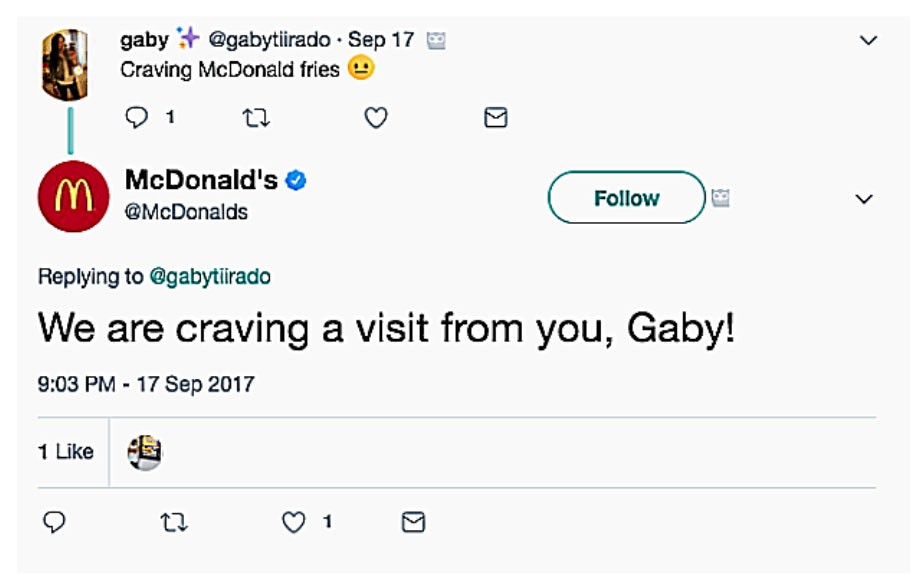
- Always be fair and trustworthy in regards to your ad audience. They’re depending on you to recommend and/or sell products to them that will genuinely benefit them in their lives and make their lives a little kinder or even better. While not everyone can gauge the usefulness of a product right away, if you know a certain product doesn’t work, don’t advertise it to your audience. If it’s a product with a sketchy history, steer clear and recommend more trustworthy, effective products to your audience.
Diib®: Moving Toward Success with your Ad Audience
Learning to pick the right ad audience for every message or product you want to share with the world will take some time. And you won’t always get it right, but the more thought and heart you put into your ad audience selection, the greater the likelihood of success for that particular campaign. Social media is a large and exciting universe for anyone who wants to market to others. The conversations are animated, the angst is passionate, and the stakes are high.
Diib offers customized social analytics solutions for thousands of businesses just like yours. It can be difficult to juggle a business and all the SEO components that go with that, not to mention adding social media into the mix. Here are some of the features that will help you with your social media campaigns:
- Social media integration and performance
- Platform specific audience demographics
- Keyword, indexing and backlink monitoring and tracking tools
- User experience and mobile speed optimization
- Technical SEO monitoring
Click here for your free scan or simply call 800-303-3510 to speak to one of our growth experts.
FAQ’s
Your specific social media audience is a group of consumer that would most likely be interested in buying your product or service. These are the people you would want to customize your ads to target. This can be dictated by age, income, location, gender, interests and many other factors.
There are 4 types of people that utilize social media. Here are those audiences:
- Friendly: You’ll want to reinforce what they already believe and/or want.
- Apathetic: These are the people that need convincing that your product matter to them.
- Uninformed: These are the people that require all the facts and education they can get before they make a decision.
- Hostile: About all you can do here is offer respect and acknowledge their differing viewpoint.
You should always have at least 250,000 people OR 10% of your local area within your audience for optimal results.
Advertising with social media is a much more effective and lucrative way to get leads and transform potential customers into loyal, returning ones. Unlike traditional advertising, social media allows you to interact with your customers and build trusting relationships.
You can easily spend between $200 and $800 a month on a new Facebook ad campaign. This depends largely on the size and scope of your business, as well as your overall goals for growth.



